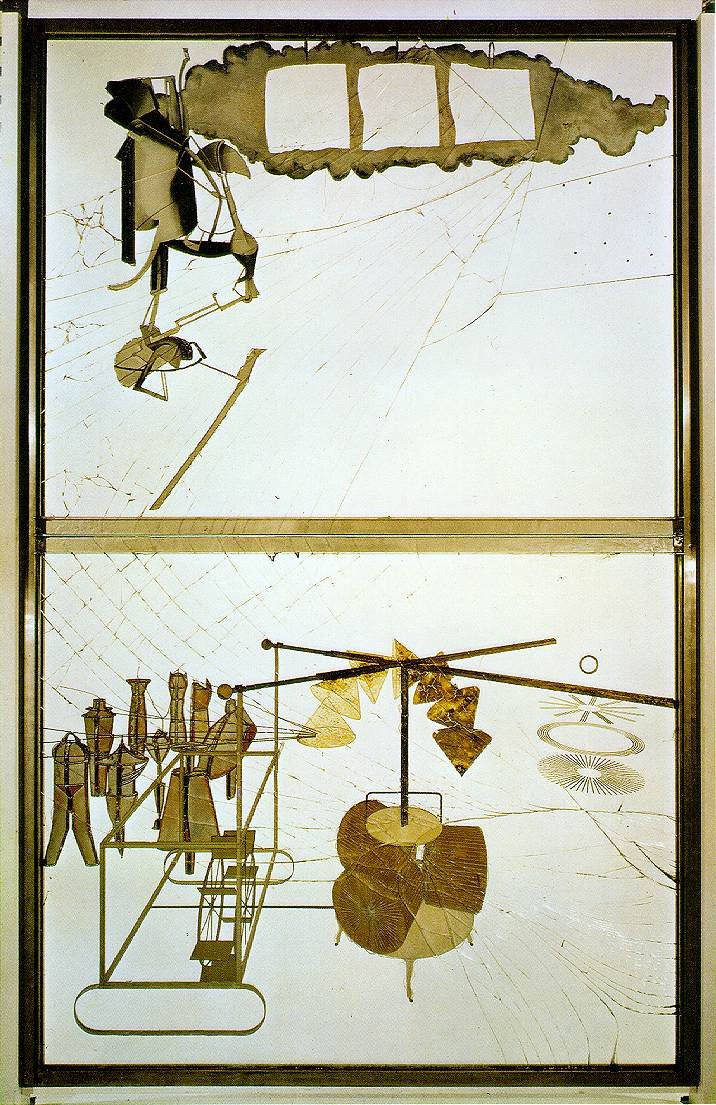The Bride Stripped Bare By Her Bachelors, Even
| The Bride Stripped Bare by Her Bachelors, Even (The Large Glass) | |
|---|---|
| French: La mariée mise à nu par ses célibataires, même (Le Grand Verre) |
|
 |
|
| Artist | Marcel Duchamp |
| Year | 1915–23 |
| Type | Oil, varnish, lead foil, lead wire, and dust on two glass panels |
| Dimensions | 277.5 cm × 175.9 cm (109.25 in × 69.25 in) |
| Location | Philadelphia Museum of Art, Philadelphia |
The Bride Stripped Bare by Her Bachelors, Even (La mariée mise à nu par ses célibataires, même), most often called The Large Glass (Le Grand Verre), is an artwork by Marcel Duchamp over 9 feet (2.7 m) tall, and freestanding. Duchamp worked on the piece from 1915 to 1923, creating two panes of glass with materials such as lead foil, fuse wire, and dust. It combines chance procedures, plotted perspective studies, and laborious craftsmanship. Duchamp's ideas for the Glass began in 1913, and he made numerous notes and studies, as well as preliminary works for the piece. The notes reflect the creation of unique rules of physics, and myth which describes the work.
It is at first sight baffling in iconography and unclassifiable style. Yet this glass construction is not a discrete whole. The Bride Stripped Bare by Her Bachelors, Even is also the title given to The Green Box notes (1934) as Duchamp intended the Large Glass to be accompanied by a book, in order to prevent purely visual responses to it. The notes describe that his "hilarious picture" is intended to depict the erotic encounter between the "Bride," in the upper panel, and her nine "Bachelors" gathered timidly below in an abundance of mysterious mechanical apparatus in the lower panel.The Large Glass was exhibited in 1926 at the Brooklyn Museum before it was broken during transport and carefully repaired by Duchamp. It is now part of the permanent collection at the Philadelphia Museum of Art. Duchamp sanctioned replicas of The Large Glass, the first in 1961 for an exhibition at Moderna Museet in Stockholm and another in 1966 for the Tate Gallery in London. The third replica is in Komaba Museum, University of Tokyo.
The Large Glass consists of two glass panels, suspended vertically and measuring 109.25 in × 69.25 in (277.5 cm × 175.9 cm). The entire composition is shattered, but it rests sandwiched between two pieces of glass, set in a metal frame with a wooden base. The top rectangle of glass is known as the Bride's Domain; the bottom piece is the Bachelors' Apparatus. It consists of many geometric shapes melding together to create large mechanical objects, which seem to almost pop out from the glass and ever-changing background.
All forms on the glass are outlined with lead wire and filled in with earth tone oil paint. The colors range from pale grey to gold to dark brown and black. Some figures are bumpy and cloudy, and contain the dust left on them during the time which the unfinished work lay dormant, which seems to be an attempt at capturing the dynamic passage of time in a sedate work.
...
Wikipedia
